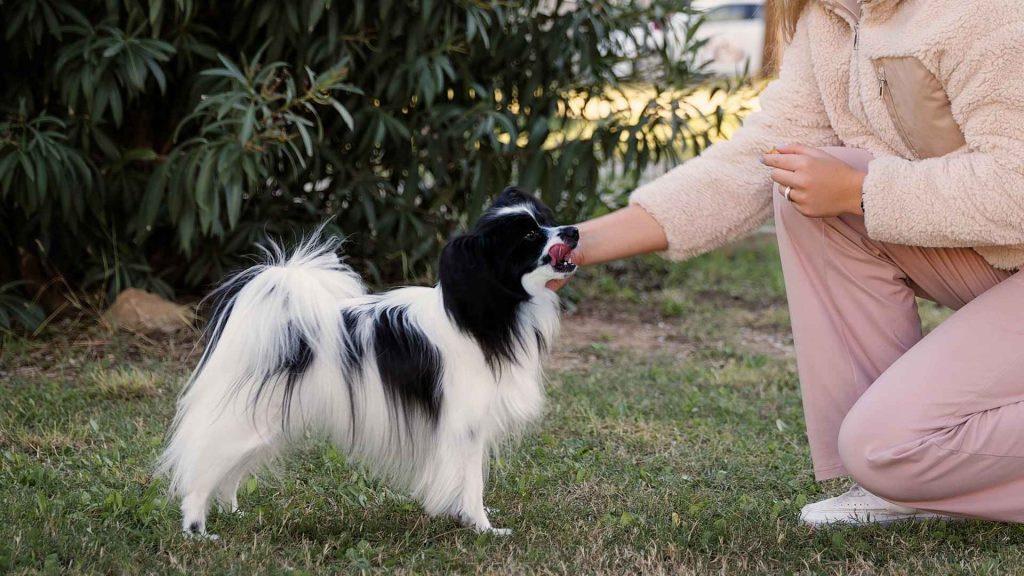People breed the Papillon dog for its intelligence, beauty, and companionship. Papillons excel in obedience and agility sports, making them popular in competitions. Their butterfly-like ears and elegant appearance attract breeders focused on show standards. Families value Papillons for their affectionate nature, long lifespan, and adaptability as both lap dogs and active pets.

Papillon 101: The Breed In A Nutshell
The Papillon (French for “butterfly”) is a small, fine-boned toy dog known for distinctive fringed ears, a plumed tail, and a lively, affectionate personality. At 5–10 pounds, they’re sturdy enough for sports yet portable and adaptable for city or suburban life. Recognized by major kennel clubs, the breed standard prioritizes alert expression, sound movement, and a silky, single coat that’s surprisingly low odor.
Key traits worth preserving:
- Intelligence and trainability
- Confidence with a friendly demeanor
- Efficient, effortless movement and balance
- Distinct head type and butterfly ears (Papillon) or drop ears (Phalène)
Breeders who do it right focus on maintaining these hallmarks while reducing inherited disease risk and avoiding extremes in size or temperament.
Why People Breed Papillons: Core Motivations
From my experience mentoring new breeders and working alongside show and sport enthusiasts, the motivations tend to cluster into several responsible categories.
Breed Preservation
- Maintain historical type, temperament, and correct structure outlined in reputable standards.
- Steward genetic diversity to keep this centuries-old companion thriving.
Performance And Companionship
- Papillons excel in agility, rally, obedience, and scent work thanks to their biddability and quickness.
- Their affectionate, social nature makes them superb therapy and emotional-support candidates when properly evaluated.
Health And Improvement
- Ethical programs aim to reduce patellar luxation, progressive retinal atrophy (PRA), neuropathy (NAD), mitral valve disease, and dental crowding through testing and careful selection.
- Success is measured over generations, not just a single litter.
Education And Ambassadorship
- Thoughtful breeders teach puppy buyers about training, grooming, dental care, and enrichment, improving long-term welfare.
Show Ring Excellence
- Competing in conformation helps verify adherence to structure and type, which correlates with sound movement and durability.
Important note: Profit should not be the primary driver. Ethical Papillon breeding is resource-intensive and seldom lucrative when done correctly.

The Health Blueprint: Testing, Screening, And Genetics
Responsible Papillon breeding starts long before pairing two dogs.
Core Health Tests
- Orthopedic: screening for patellar luxation (via veterinary exams).
- Eyes: annual ophthalmic evaluations for PRA and other inherited eye diseases.
- Cardiac: auscultation and, when indicated, echocardiograms to monitor for mitral valve disease.
- DNA: panels for PRA variants, NAD, and other breed-relevant markers.
- Dentition: monitor bite and crowding; prioritize robust dental health.
Breeding Strategy
- Use tools like the Coefficient of Inbreeding (COI) to balance type with diversity.
- Avoid doubling up on known recessive risks; mate selection should be data-informed, not trend-driven.
- Maintain records: health results, pedigrees, and puppy follow-ups to evaluate outcomes.
Red Flags
- “Parents are healthy” without documented testing.
- Extremely small sizes advertised as “teacup”—often linked to higher health risk.
- Frequent litters or no interest in long-term puppy outcomes.
Tip from experience: I ask to see the breeder’s testing schedule and litter outcome notes. The best breeders love showing their system because it proves their program’s integrity.

Temperament, Trainability, And Everyday Life
Papillons are sometimes called the “border collies of the toy world.” They’re alert, whip-smart, and thrive on mental stimulation.
Why This Matters For Breeding
- Selecting for stable, confident, people-friendly temperaments yields dogs that excel in agility, obedience, therapy work, and as delightful companions.
- Breeding away from excessive shyness or reactivity reduces stress and improves quality of life for dogs and owners.
Living With A Papillon
- Expect a curious shadow who enjoys training games, puzzle feeders, and short bursts of zoomies.
- With consistency and positive reinforcement, house manners come quickly.
Personal note: In classes I’ve taught, first-time owners are often surprised by how eagerly Papillons check in, offer behaviors, and problem-solve. When breeders prioritize these traits, training feels like a dance, not a tug-of-war.

Ethics And Welfare: Doing Right By The Breed
Ethical breeding respects the dog before the dream.
Placement And Lifetime Responsibility
- Good breeders offer contracts with spay/neuter terms for pets, return-to-breeder clauses, and guidance for the dog’s lifetime.
Puppy Raising Standards
- Early neurological stimulation, socialization (sights, sounds, surfaces), and gentle handling set puppies up for resilience.
- Clean environments, parasite control, and incremental exposure schedules reduce fear and disease risk.
Transparency And Boundaries
- Clear communication about waiting lists, pricing, and health expectations.
- Willingness to say “not a match” if a Papillon’s needs don’t suit an applicant’s lifestyle.
Legal And Cultural Compliance
- Adherence to local breeding laws, microchipping rules, and truthful advertising is non-negotiable.
Lesson learned: The most respected Papillon breeders turn more people away than they accept—and that’s a sign of ethics, not arrogance.

The Economics Of Responsible Papillon Breeding
Breeding well costs money and time.
Typical Expenses
- Health testing, genetic panels, stud fees, whelping supplies, emergency funds.
- High-quality nutrition, vaccinations, microchipping, registration, and puppy socialization resources.
Why Prices Vary
- Proven health-tested lines, titled parents, and breeder support command higher prices, reflecting invested care—not “markup.”
Sustainability
- Programs plan litters based on homes lined up and the breeder’s capacity to raise puppies right, not on market spikes.
Reality check: When I audit budgets with new breeders, many are surprised the first well-planned litter often breaks even at best.

How To Vet A Papillon Breeder
Use this checklist to protect yourself—and the breed.
- Ask for documented health tests for both parents.
- Request to meet at least the dam and review temperaments in person or via live video.
- Review contracts, health guarantees, and spay/neuter policies for pet homes.
- Evaluate how puppies are raised: early handling, structured socialization, clean spaces.
- Ask about lifetime support, training advice, and return policies.
- Look for participation in conformation or sports—evidence the dogs are evaluated beyond looks alone.
- Expect questions about your lifestyle. Responsible breeders are selective.
Pro tip: A breeder who invites questions, shares test results proactively, and offers references is signaling trustworthiness.

Common Mistakes To Avoid When Breeding Papillons
– Breeding without a mentor or plan—fastest route to compounding health or temperament problems.
– Ignoring dental health and patellas—two common toy-breed pain points.
– Selecting only for looks (like ear fringe) while neglecting structure or behavior.
– Overusing a “popular sire,” which can bottleneck genetics and spread recessive issues.
– Skipping puppy socialization windows (3–16 weeks), leading to long-term fearfulness.
– Marketing “rare” colors or “teacups” as selling points rather than focusing on health and soundness.
FAQ’s
Is the Papillon a good breed for first-time dog owners?
Yes—if you’re prepared to provide daily mental engagement. Their intelligence makes training rewarding, but they can become vocal or mischievous without structure and enrichment.
What health tests should I see before buying a Papillon puppy?
Ask for patellar evaluations, annual eye exams for PRA and related issues, cardiac checks for mitral valve disease, and DNA tests for breed-relevant conditions like NAD. Documentation matters.
Are Papillons good with children and other pets?
Generally yes, with supervision. Because they’re small, teach gentle handling. Many Papillons do well with polite kids and can coexist with other dogs and even cats when introduced thoughtfully.
Why do ethical breeders have waitlists?
Responsible programs plan litters around health, dams’ recovery times, and quality homes. Waitlists help match puppies to families rather than producing to meet impulse demand.
What’s the difference between a Papillon and a Phalène?
They’re the same breed, differentiated by ear carriage: Papillon ears are erect and fringed; Phalène ears are drop. Both should share sound structure and temperament.
Do Papillons need a lot of exercise?
They need moderate physical activity plus robust mental stimulation. Short walks, training games, and puzzle work often satisfy them, with extra outlets for sport-minded dogs.
Conclusion
People breed the Papillon dog to preserve a beloved, historic companion known for brilliance, beauty, and buoyant spirit—while advancing health, structure, and temperament through careful selection. If you’re considering this breed, prioritize breeders who test, track outcomes, and stand by their dogs for life. Ready to go deeper? Explore reputable clubs, attend a show or agility trial, and speak with mentors. Subscribe for more ethical breeding guides or drop your questions in the comments—I’m happy to help you make an informed decision.
I’ve loved dogs all my life and have cared for many different breeds over the years. Here, I share simple tips, stories, and helpful advice for all dog lovers. Whether you’re a new pet parent or a lifelong dog fan, you’ll find something useful and fun on my site.


